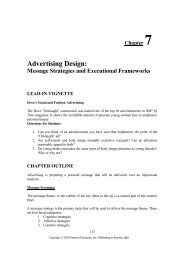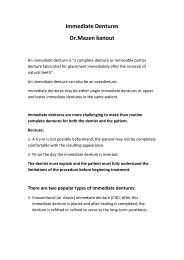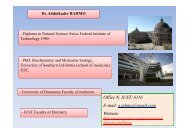pigmented lesions of oral mucosa.pdf
pigmented lesions of oral mucosa.pdf
pigmented lesions of oral mucosa.pdf
You also want an ePaper? Increase the reach of your titles
YUMPU automatically turns print PDFs into web optimized ePapers that Google loves.
influence <strong>of</strong> the drug or deposition <strong>of</strong> iron after damage to<br />
the dermal vessels.<br />
Quinidine<br />
Mucosal discolouration is described as blue–grey or blue–<br />
black<br />
in most cases only the hard palate is involved<br />
Physiologic Pigmentation<br />
ETIOLOGY<br />
due to greater melanocyte activity rather than a greater<br />
number <strong>of</strong> melanocytes<br />
Clinical features<br />
The colour ranges from light to dark<br />
brown.<br />
The attached gingiva is the most common intra<strong>oral</strong> site <strong>of</strong><br />
such pigmentation<br />
bilateral, well-demarcated, ribbon-like, dark brown band<br />
that usually spares the marginal gingiva<br />
Pigmentation <strong>of</strong> the buccal <strong>mucosa</strong>, hard palate, lips and<br />
tongue may also be seen as brown patches with less welldefined<br />
borders.<br />
Smoker’s Melanosis<br />
ETIOLOGY<br />
increased production <strong>of</strong> melanin, which may provide a biologic<br />
defence against the noxious agents present in tobacco smoke.<br />
Clinical features<br />
The brown–black <strong>lesions</strong> most <strong>of</strong>ten involve the<br />
anteriorlabial gingiva followed by the buccal <strong>mucosa</strong>.<br />
Smoker’s melanosis usually disappears within 3 years <strong>of</strong><br />
smoking cessation









